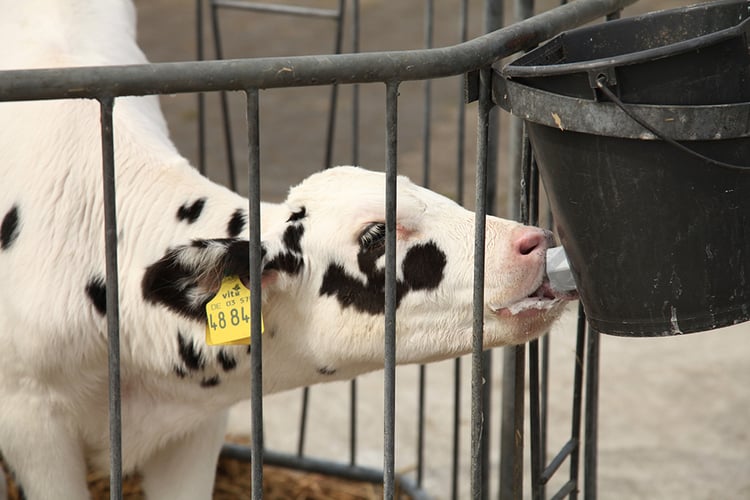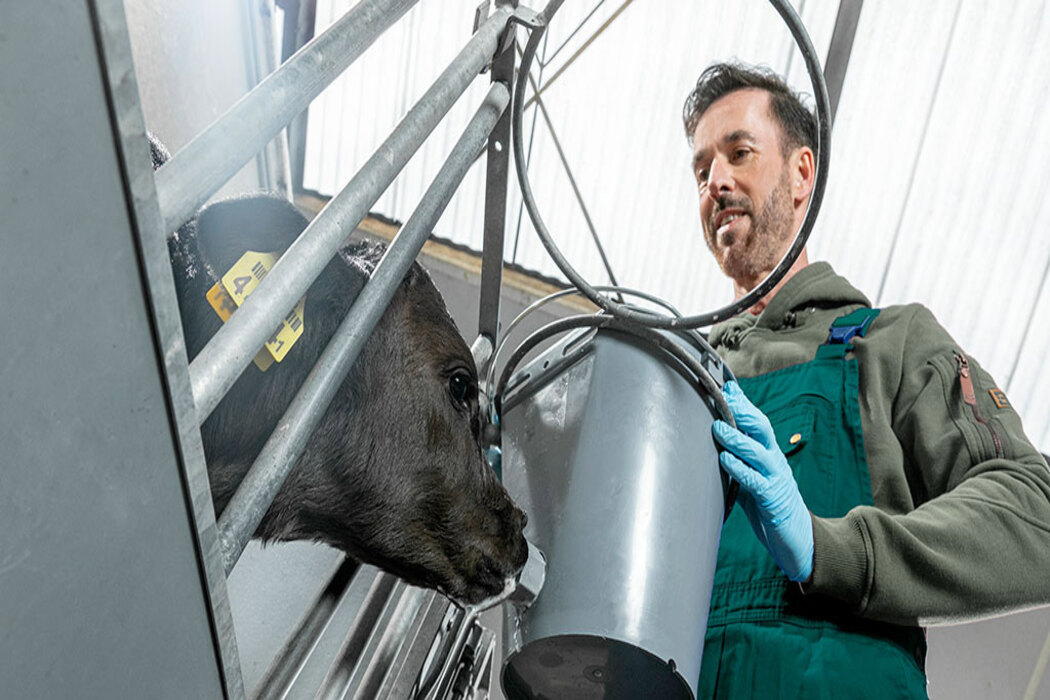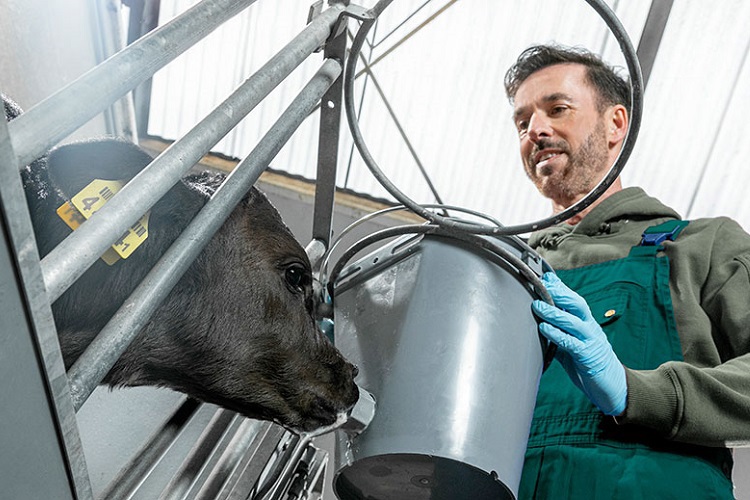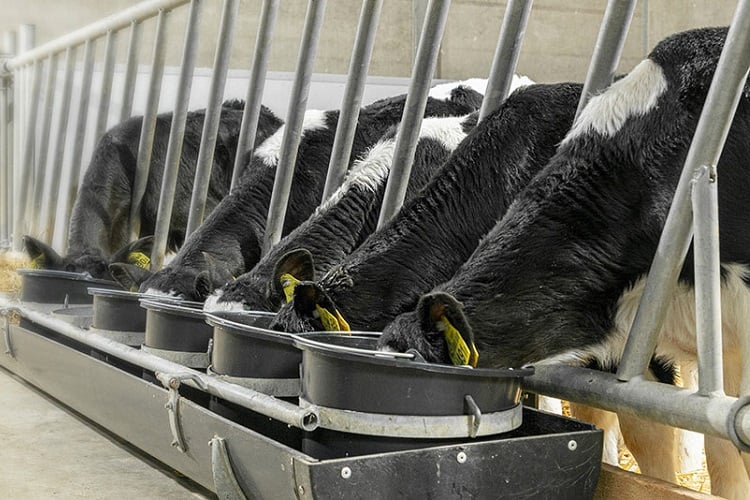
- LifeStart
- Lifestart themes
- Role of fat in calf nutrition
Key takeaways from the research
-
Calves fed an energised calf milk replacer with a fat level increased to 25% grew 100 g/day more compared to calves fed a CMR with 18% fat
-
The calves in the energised calf milk replacer group had an ADG above 1000 g/day

Dairy calves fed energised calf milk with 25% fat grew 100 g/day more compared to calves fed a CMR with 18% fat
Several authors have shown that elevated planes of pre-weaning nutrition increase pre-weaning daily gain[1,2,3,4,5,6,7,8,9,10], improve fertility, increase future milk production and eventually increase average lifetime daily gain.
Pre-weaning levels of nutrition can be increased by increasing the amounts of calf milk replacer fed, but an alternative would be to increase the energy density of the CMR fed. An energised calf milk replacer in which the amount of fat was increased to 25% was compared to a CMR with 18% fat.
Study design
The trial was carried out on a commercial farm. A total of 45 calves were included in the study and divided into 3 groups. All groups were fed colostrum ad libitum on day 1 and were weaned at 70 days of age according to a step-down weaning schedule. Weight was recorded weekly up to day 90 (3 weeks after weaning).
The feeding schedules in each of the 3 groups were as follows:
• Group 1: whole milk between day 2 and day 20, followed by a CMR with 18% fat from day 21 until day 70
• Group 2: whole milk between day 2 and day 20, followed by energised calf milk replacer with 25% fat from day 21 until day 70
• Group 3: energised calf milk replacer with 25% fat from day 2 until day 70
Results
The average daily gain of the 3 groups from birth to day 20 was very similar, with the groups 1 and 2 fed whole milk having an ADG 1040 g/day and 1070 g/day respectively vs. 1100 g/day for group 3 being fed the energised calf milk replacer.
ADG from day 21 to day 70 was much lower in the animals in group 1 being fed the CMR with 18% fat growing 790 g/day vs groups 2 and 3 fed the energised calf milk replacer (960 g/day for group 2 and 940g/day for group 3 respectively).
This resulted in a difference in ADG between birth and day 90 of over 100 g/day with the calves fed the CMR with 18% fat having an ADG of 930 g/day vs. 1040 g/day and 1050 g/day in the 2 groups fed the energized calf milk replacer with 25% fat.
References
[1] Shamay, A., D. Werner, U. Moallem, H. Barash, and I. Bruckental. 2005. Effect of nursing management and skeletal size at weaning on puberty, skeletal growth rate, and milk production during first lactation of dairy heifers. J. Dairy Sci. 88:1460–1469.
[2] Faber, S. N., N. E. Faber, T. C. McCauley, and R. L. Ax. 2005. Case study: Effects of colostrum ingestion on lactational performance. Prof. Anim. Sci. 21:420–425.
[3] Davis Rincker LE, VandeHaar MJ, Wolf CA, Liesman JS, Chapin LT and Weber Nielsen MS, Effect of intensified feeding of heifer calves on growth, pubertal age, calving age, milk yield, and economics. J. Dairy Sci 94:3554-3567 (2011).
[4] Moallem, U., D. Werner, H. Lehrer, M. Zachut, L. Livshitz, S. Yakoby, and A. Shamay. 2010. Long-term effects of ad libitum whole milk prior to weaning and prepubertal protein supplementation on skeletal growth rate and first-lactation milk production. J. Dairy Sci. 93:2639–2650.
[5] Raeth-Knight, M., H. Chester-Jones, S. Hayes, J. Linn, R. Larson, D. Ziegler, B. Ziegler, and N. Broadwater. 2009. Impact of conventional or intensive milk replacer programs on Holstein heifer performance through six months of age and during first lactation. J. Dairy Sci. 92:799–809.
[6] Drackley, J. K., B. C. Pollard, H. M. Dann, and J. A. Stamey. 2007. First-lactation milk production for cows fed control or intensified milk replacer programs as calves. J. Dairy Sci. 90(Suppl. 1):614.
[7] Terré, M., C. Tejero, and A. Bach. 2009. Long-term effects on heifer performance of an enhanced growth feeding programme applied during the pre-weaning period. J. Dairy Res. 76:331–339.
[8] Soberon F, Raffrenato E, Everett RW and Van Amburgh ME. 2012. Preweaning milk replacer intake and effects on long-term productivity of dairy calves. J. Dairy Sci. 95:783-793.
[9] Bar-Peled et al., 1997. Increased weight gain and effects on production parameters of Holstein heifer calves that were allowed to suckle from birth to six weeks of age. J. Dairy Sci; 80:2523-8.
[10] Bolt, A. 2019, Meta-analysis to calculate the effect of rearing intensity on functionality of dairy cows, Research paper Mecklenburg Vorpommern Landesforschungsanstalt für Landwirtschaft und Fischerei.






